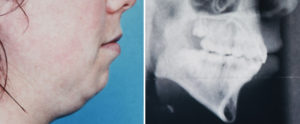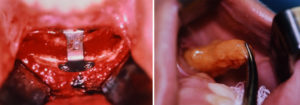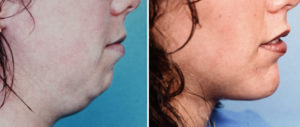Background: The lower face is perceived by the shape and projection of the chin and the cervicomental angle. A fairly well defined neck angle and a discernible chin are positive facial features regardless of age, gender or ethnicity. This speaks to the popularity of such plastic surgery procedures like chin augmentation and neck liposuction which strive to achieve these individual facial improvements.
A well known lower facial aesthetic deformity is the double chin. This does not occur because one really has two chins, it just looks like one does. The real chin is usually horizontally short but creates the upper part of the double chin. The second ‘chin’ is a fat and skin roll in the upper neck that sits below the bony chin. It is more recessed than the bony chin and thus creates a double roll in profile, like a set of stairs, into the lower neck. The double chin often appears as part of an overall facial lipodystrophy in its more severe form.



As the chin bone is brought forward it carries with it the genioglossus and geniohyoid muscle. This creates a tissue stretch in the upper neck and helps elevate the ‘second chin’ of the double chin. This is an effect that is not created by the placement of a chin implant on the bone. Which is why in cases of severe double chin cortrection the sliding genipoplasty is the preferred approach to implants even though it is far less initially appealing to do so.
Highlights:
- The double chin is always associated with a short lower jaw projection and a thicker fatty neck.
- ]The diametric movements of stretching out the chin and pulling back on the neck creates the best double chin correction.
- The best chin augmentation for the severe double chin is a sliding genioplasty as the bone movement lengthen the neck muscles as well.
Dr. Barry Eppley
Indianapolis, Indiana


